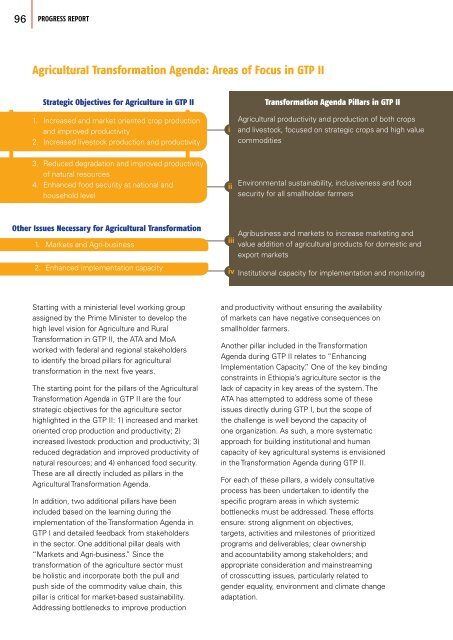PROGRESS REPORT
1LLMfQ4
1LLMfQ4
You also want an ePaper? Increase the reach of your titles
YUMPU automatically turns print PDFs into web optimized ePapers that Google loves.
96 <strong>PROGRESS</strong> <strong>REPORT</strong> GTP II TRANSFORMATION AGENDA 97<br />
Agricultural Transformation Agenda: Areas of Focus in GTP II<br />
Strategic Objectives for Agriculture in GTP II<br />
1. Increased and market oriented crop production<br />
and improved productivity<br />
2. Increased livestock production and productivity<br />
3. Reduced degradation and improved productivity<br />
of natural resources<br />
4. Enhanced food security at national and<br />
household level<br />
Other Issues Necessary for Agricultural Transformation<br />
1. Markets and Agri-business<br />
2. Enhanced implementation capacity<br />
Starting with a ministerial level working group<br />
assigned by the Prime Minister to developthe<br />
high level vision for Agriculture and Rural<br />
Transformation in GTP II, the ATA and MoA<br />
worked with federal and regional stakeholders<br />
to identify the broad pillars for agricultural<br />
transformation in the next five years.<br />
The starting point for the pillars of the Agricultural<br />
Transformation Agenda in GTP II are the four<br />
strategic objectives for the agriculture sector<br />
highlighted in the GTP II: 1) increased and market<br />
oriented crop production and productivity; 2)<br />
increased livestock production and productivity; 3)<br />
reduced degradation and improved productivity of<br />
natural resources; and 4) enhanced food security.<br />
These are all directly included as pillars in the<br />
Agricultural Transformation Agenda.<br />
In addition, two additional pillars have been<br />
included based on the learning during the<br />
implementation of the Transformation Agenda in<br />
GTP I and detailed feedback from stakeholders<br />
in the sector. One additional pillar deals with<br />
“Markets and Agri-business.” Since the<br />
transformation of the agriculture sector must<br />
be holistic and incorporate both the pull and<br />
push side of the commodity value chain, this<br />
pillar is critical for market-based sustainability.<br />
Addressing bottlenecks to improve production<br />
i<br />
ii<br />
iii<br />
Transformation Agenda Pillars in GTP II<br />
Agricultural productivity and production of both crops<br />
and livestock, focused on strategic crops and high value<br />
commodities<br />
Environmental sustainability, inclusiveness and food<br />
security for all smallholder farmers<br />
Agribusiness and markets to increase marketing and<br />
value addition of agricultural products for domestic and<br />
export markets<br />
iv Institutional capacity for implementation and monitoring<br />
and productivity without ensuring the availability<br />
of markets can have negative consequences on<br />
smallholder farmers.<br />
Another pillar included in the Transformation<br />
Agenda during GTP II relates to “Enhancing<br />
Implementation Capacity.” One of the key binding<br />
constraints in Ethiopia’s agriculture sector is the<br />
lack of capacity in key areas of the system. The<br />
ATA has attempted to address some of these<br />
issues directly during GTP I, but the scope of<br />
the challenge is well beyond the capacity of<br />
one organization. As such, a more systematic<br />
approach for building institutional and human<br />
capacity of key agricultural systems is envisioned<br />
in the Transformation Agenda during GTP II.<br />
For each of these pillars, a widely consultative<br />
process has been undertaken to identify the<br />
specific program areas in which systemic<br />
bottlenecks must be addressed. These efforts<br />
ensure: strong alignment on objectives,<br />
targets, activities and milestones of prioritized<br />
programs and deliverables; clear ownership<br />
and accountability among stakeholders;and<br />
appropriate consideration and mainstreaming<br />
of crosscutting issues, particularly related to<br />
gender equality, environment and climate change<br />
adaptation.<br />
Agricultural Commercialization Clusters<br />
Another innovation that has been introduced<br />
into the Transformation Agenda during GTP II is<br />
the concept of Agricultural Commercialization<br />
Clusters (ACCs). In the past, Ethiopia has<br />
launched geographically based initiatives that<br />
aimed to integrate and link interventions within<br />
the agriculture sector to broader economic plans.<br />
Initiatives such as the Economic Growth Corridor<br />
Initiative have had strong conceptual grounding<br />
but have faced challenges in implementation.<br />
Geographically focused approaches (also known<br />
as economic corridors or zones) have been<br />
successfully used in Asian, Latin American,<br />
and African countries to drive agricultural<br />
transformation and rural industrialization.<br />
Geographic and commodity-specific clusters that<br />
focus on commercialization provide a strategic<br />
and sustainable platform to drive transformation<br />
of agriculture, and consequently, economic<br />
growth.<br />
The ACC initiative in Ethiopia has four main<br />
objectives:<br />
1. Drive specialization, diversification and<br />
commercialization of agriculture for priority<br />
commodity value chains<br />
2. Enhance production and productivity,<br />
quality of outputs, aggregation, value<br />
addition and market linkages<br />
3. Provide an integrated platform to<br />
implement multiple, priority interventions<br />
across the value chain and across sectors<br />
4. Improve focus and coordination among<br />
public sector, private sector, donors and<br />
NGOs<br />
Using a multiple commodity production system<br />
approach, each cluster (designed for optimal<br />
size to encompass 5-15 woredas) will build<br />
connections across all components of thevalue<br />
chain. Clusters have been selected based on their<br />
production potential, natural resource availability,<br />
access to market, and presence of the private<br />
sector around priority commodities. For the first<br />
phase of implementation, prioritized commodities<br />
include the major cereal crops (tef, wheat, maize),<br />
horticulture crops (pepper, potato, onion), highvalue<br />
crops (coffee and sesame), and livestock<br />
products (various meats, cow milk, eggs and<br />
honey).<br />
The Transformation Agenda aims to leverage<br />
the Agricultural Commercialization Clusters<br />
initiative as an “anchor” deliverable by integrating<br />
all interventions for impact on the ground. It<br />
provides a mechanism for aligning various donor<br />
and government interventions and engaging<br />
smallholder farmers in a coordinated manner.<br />
It also provides smallholder farmers with a<br />
structured mechanism to integrate their input,<br />
needs and aspirations into the planning process.


